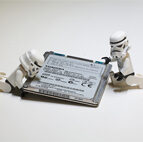
Even though MacBook and Mac Pros have been getting larger and larger internal drives, those of us with SSD drives are still fighting the storage wars, trying to keep the clutter off of drives that while extremely fast, aren’t always the largest when it comes to capacity.
The longer you have your Mac the more junk you’ll ultimately collect from iOS backups, downloads, and even in iTunes. Reclaim disk space and use it for more important things today with these 5 tips.
Clear Out Downloads
The first stop for clearing out junk space from your Mac should definitely be the Downloads folder. This is the most likely culprit for storing up unnecessary files and taking up much needed space.
Open up your Downloads folder by accessing Finder and clicking on Downloads in the sidebar. Next, go through each file and remove the old installation files and used documents that are just taking up space. Ideally you don’t want to leave anything in your Downloads folder. Get into the habit of taking new application installers out of it immediately so it never gets clogged up again.
Delete Unnecessary iTunes Files
iTunes is a pretty big hog when it comes to storage space. There are a few key areas that you can focus on to reclaim disk space with some serious speed.

Videos – When you purchase an HD movie or TV show on your Mac, iTunes automatically downloads both the HD as well as the SD versions. It’s not too common to need both formats so you can delete the one that’s not being used. To fix this, look for videos that say SD/HD next to the and right-click on one of these and select “Show in Finder.” From here, delete either the SD or HD versions and leave the version you want.
Apps – If you have automatic download turned on for your Mac every app you download to your iPad, iPod Touch, and iPhone will automatically download to your Mac when you open iTunes. This means that all those apps that you download and delete because they don’t do what you want will still be downloaded on your computer. Depending on how big the app is, each app could be anywhere from 2MB up to a few gigabytes. Click on Apps in iTunes and delete all the apps you don’t use. Remember, you can always download them again from the App Store.
iTunes Downloads – When you stop a movie or TV show download halfway through the process sometimes the partial files can get stuck and be saved on your Mac. To see this open up a Finder window and go to Music > iTunes > iTunes Media > Downloads. If you’re not currently downloading any media this folder should be empty. If it isn’t, delete the files there. This can save you a few gigs if it’s overly clogged.
iTunes Match
Speaking of iTunes media, you can save an enormous amount of space by using iTunes Match for all of your music. For $25 per year you get nearly unlimited storage for your music files on Apple’s servers, which means you can remove the files from your Mac once they upload. Now you can stream your music and only store the files on your Mac that you really want.
While this does limit your ability to listen offline, you can always download specific playlists so you always have the music you want at hand. Best of all, you get unlimited commercial-free access to iTunes Radio with your iTunes Match purchase for even more storage-free listening.
Squash Old iOS Backups
Another type of file that can take up a lot of useless space is old iOS backups. When you get a new device or start a new backup of a current one, the old backup can stay saved, costing you up to 1GB per backup.

To delete an old iOS backup, open up iTunes and click the iTunes menu > Preferences. Next, click on the Devices tab and you’ll see a list of your devices that have backups stored. Each backup will be around 1 GB in size. Make 100% sure you want a backup deleted before you do, as these don’t go to the Trash, once you delete them, they’re gone for good.
Selective Sync Dropbox/Google Drive
If you’re like most people, you probably use a service like Dropbox or Google Drive to sync and backup your files. What you might not know is that you can tell both of these services to selectively sync your files so larger ones can be stored on the server and not take up space on your machine. This is perfect if you keep huge files here for one computer but don’t want them taking up all your free space on a smaller drive like those in the MacBook Air.

For Dropbox just click on the icon in the Menu Bar in OS X and click the gear icon to get to Preferences. Here, click on Account and set Selective Sync to be whatever you wish.
For Google Drive, click on the Drive icon in the Toolbar and select Preferences. Under Sync options check the Only sync some folders to this computer and select the ones you wish to sync.
Now only files you want synced to your computer will be there and ones you don’t need instant access to will still be backed up on the server and on other machines.




